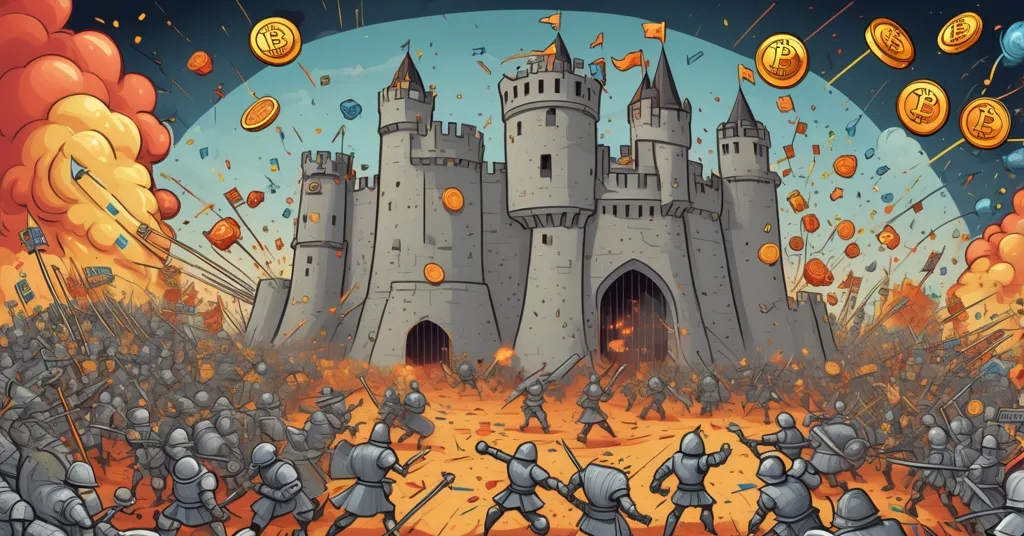Bitcoin Core vs. Knots: Echoes of Satoshi’s 15-Year Governance Battle

Bitcoin Core vs. Knots: A 15-Year Governance War Satoshi Fought
Is Bitcoin still the untamed, rebel currency Satoshi Nakamoto envisioned, or has it become a perpetual battleground for tech nerds obsessed with control? The latest clash between Bitcoin Core and Bitcoin Knots over transaction policies and arbitrary data inclusion isn’t fresh drama—it’s a rerun of a fight from 2010, when Satoshi himself drew the first blood in a governance war that still rages. With Bitcoin trading at a hefty $113,071, the stakes are sky-high, but the core question remains unchanged: What the hell is Bitcoin supposed to be?
- Historical Replay: Satoshi’s 2010 “IsStandard()” policy sparked Bitcoin’s first governance clash, mirroring today’s Core vs. Knots feud.
- Identity Crisis: Is Bitcoin strictly money, or a playground for random data and experiments?
- Real Risks: Rising fees, network bloat, and legal traps haunt both past and present debates.
- Power Struggle: Policy defaults in software shape Bitcoin’s path more than you’d think.
The 2010 Flashpoint: Satoshi’s Line in the Sand
Let’s rewind to December 2010, when Bitcoin was a scrappy little project barely on anyone’s radar. A tight-knit crew of cypherpunks and coders were tinkering with a digital currency that promised to upend the financial status quo. Then Satoshi Nakamoto released version 0.3.18 of the Bitcoin software, introducing the “IsStandard()” policy. For the uninitiated, this was a rule baked into the code to only accept predefined, “safe” transaction types in blocks, blocking anything weird or untested that might jeopardize the network’s stability. Think of it as a bouncer at the Bitcoin club—only VIP transaction formats got in.
This wasn’t just a technical update; it was a Molotov cocktail tossed into the community. Bitcoin’s first governance dispute erupted as folks split over a fundamental issue: Should Bitcoin stick to being peer-to-peer cash, or open its doors to wild, experimental uses? On one side, you had free-spirited advocates pushing for a hands-off approach. Forum user “da2ce7” argued that market forces would sort out blockchain clutter naturally through fees, saying:
Transaction fees will pay for the generation of the chain in the future… if [others] want to include carefully crafted transactions… they must include the appropriate compensation.
Theymos, an early influencer and forum moderator, doubled down, insisting miners would gobble up any transaction with a fee attached. He even coded a patch to ditch relay restrictions, declaring:
All miners have an interest in including any and all fee-carrying transactions… The restriction on relaying these transactions should be removed, at the very least.
But not everyone was ready to turn Bitcoin into a digital Wild West. Jeff Garzik, a key developer back then, sounded the alarm on non-currency data jacking up fees and pushing out regular users. He warned:
Will disadvantage people who use bitcoins… as cash as intended.
Garzik wasn’t just worried about economics—he flagged legal landmines. What happens when someone embeds illegal or sketchy content into an immutable blockchain? Regulators don’t care about your decentralization gospel when they’re slapping cuffs on node operators.
Satoshi, along with early dev Gavin Andresen, took a middle ground—sort of. They prioritized security through a whitelist of approved transaction types, with Satoshi explaining the move as an “IsStandard() check to only include known transaction types in blocks.” But he wasn’t a total hardliner, leaving wiggle room for niche data uses like timestamping small snippets. Later, he reflected:
I came to agree with Gavin about whitelisting when I realized how quickly new transaction types can be added.
Andresen backed this up, stating, “Whitelisting known-safe templates was the right thing to do.” It was less about killing innovation and more about not letting the network implode from untested gimmicks.
Core vs. Knots: Same Fight, New Faces
Fast forward to now, and the Bitcoin Core vs. Bitcoin Knots drama feels like a gritty sequel no one asked for. If you’re new to the scene, Bitcoin Core is the main software most Bitcoin nodes run, maintained by a cadre of developers who set default rules for validating and relaying transactions. Bitcoin Knots is an alternative client, often tinkering with different defaults, especially on whether to relay “arbitrary data”—think non-financial content like images or text. Developer Peter Todd summed it up on X with a smirk:
Good read. tl;dr: everything that has been said about Core vs Knots has already been said almost 15 years ago.
He’s not wrong. Swap out 2010’s BitDNS dreams for today’s Ordinals inscriptions, and the script reads the same. For a deeper dive into this historical parallel, check out this analysis of Bitcoin Core and Knots echoing Satoshi’s early battles.
Ordinals, for the unfamiliar, are a recent innovation letting users attach unique data—think JPEGs or memes—to individual satoshis, Bitcoin’s smallest unit. It’s like NFTs, but on Bitcoin’s blockchain, creating collectibles etched into history. Cool, right? Not so fast. When Ordinals hype peaked in 2023, transaction fees spiked as data-heavy inscriptions clogged mempools, leaving regular users paying absurd costs for simple transfers. Core’s camp often leans toward restricting such data to keep Bitcoin lean and focused on money. Knots, by contrast, sometimes plays looser, relaying more transaction types by default. It’s 2010 all over again: security and purpose versus experimentation.
Risks and Rewards: The Data Dilemma
Don’t brush this off as geeky trivia. The Bitcoin Core vs. Knots debate cuts to the heart of what this network stands for. Let’s break down the stakes with no sugarcoating.
- Fee Hell: Non-currency data like Ordinals can drive up fees, pricing out folks using Bitcoin as actual cash. During peak Ordinals mania in early 2023, fees hit levels where sending $10 cost $20—absurd for a currency meant to disrupt banks.
- Blockchain Bloat: Think of the blockchain as a shared attic. Cram it with junk—random memes, gifs, whatever—and there’s no space for essentials. Nodes struggle to sync, becoming slower and costlier to run, which centralizes the network as only the well-funded survive.
- Legal Quicksand: If some edgelord embeds illicit content via inscriptions, it’s on every node forever. Governments won’t hesitate to target operators in strict jurisdictions. Remember Napster? Decentralization didn’t save it from lawsuits.
But here’s the flip side: restricting data kills potential. Early ideas like BitDNS—a way to use Bitcoin for decentralized domain naming—paved the path for later innovations. Ordinals, for all their baggage, prove Bitcoin can host unique use cases beyond transfers. Stifling that entirely risks turning Bitcoin into a fossil, unable to adapt as the world moves on. It’s a tightrope, and neither Core nor Knots has the perfect balance.
Reality check: Would you still use Bitcoin if fees outstrip your transaction’s value just because someone’s digital doodle hogged the block? That’s not freedom—it’s a new kind of toll road.
Policy vs. Protocol: The Shadowy Power Play
Here’s where it gets sneaky. Bitcoin’s protocol—its core rules like the 21 million coin cap—is rock-solid, enforced by consensus across nodes. Policy, though, is different. It’s the default behavior in software like Core or Knots, deciding what transactions get relayed or prioritized before they’re even mined. Think of protocol as the foundation of a house, unchangeable without breaking everything. Policy? That’s the house rules—flexible, debatable, and quietly influential.
Satoshi’s 2010 “IsStandard()” move was policy, not protocol. Today’s Core vs. Knots spat lives in the same gray zone. Core might set stricter relay defaults, while Knots loosens them, shaping how the network feels to users without touching Bitcoin’s bedrock rules. This isn’t trivial—it’s a power struggle. Whoever controls defaults nudges behavior, and in a decentralized system with no king, competing visions slug it out through code and community clout. It’s messy, frustrating, and honestly, kind of beautiful. That’s Bitcoin.
Lessons from History: We’ve Been Here Before
The 2010 clash wasn’t a one-off. It foreshadowed bigger wars, like the 2015-2017 block size debacle that birthed Bitcoin Cash. That fight, too, boiled down to identity: small blocks for decentralization (Core’s stance) versus bigger blocks for cheaper transactions (Cash’s pitch). Spoiler: both sides had valid points, and neither “won.” Bitcoin trudged on, antifragile through fracture.
Even earlier experiments, like colored coins—ways to tag Bitcoin for non-currency uses—echoed the same tension. Each debate reinforces a pattern: Bitcoin’s decentralized nature guarantees conflict over purpose. BitMEX Research recently traced this thread on X, reminding us these aren’t just coding quarrels—they’re existential. Core vs. Knots fits right in, another chapter in a saga of clashing ideals.
What’s Next for Bitcoin’s Soul?
So, where does this leave us? Bitcoin’s future won’t be settled by Core or Knots winning outright. It’s more likely we’ll see messy compromise—or divergence. Layer-2 solutions like the Lightning Network could ease on-chain pressure, handling microtransactions off the main blockchain while data experiments fight for scraps. But if fees keep soaring from inscriptions, Lightning’s adoption might not keep pace.
Then there’s the regulatory elephant in the room. If governments crack down on on-chain content, policy defaults in Core or Knots could become lightning rods for compliance fights. Nodes in hostile jurisdictions might drop out, shrinking the network’s resilience. On the flip side, if Bitcoin calcifies against all data use, it risks irrelevance as altcoins like Ethereum scoop up innovation niches—from NFTs to DeFi—that Bitcoin shouldn’t, and arguably can’t, fill. As a Bitcoin maximalist at heart, I’ll say it: we don’t need to do everything. Let Ethereum play digital Legoland; Bitcoin’s strength is money, pure and simple. But ignoring all adaptation is a death wish.
One last jab: some of these data experiments—Ordinals included—reek of cash-grab cosplay more than real innovation. We’re all for pushing boundaries, but let’s not pretend every gimmick is a revolution. Call out the grift when you see it, folks.
Key Takeaways and Questions for Reflection
- What triggered Bitcoin’s first governance fight in 2010?
Satoshi Nakamoto’s “IsStandard()” policy in version 0.3.18 restricted non-standard transactions for security, clashing with advocates of innovation like BitDNS who saw it as stifling potential. - How does the Bitcoin Core vs. Knots debate tie to the past?
It echoes 2010’s arguments over non-financial data, fee market impacts, and whether Bitcoin should stick to money or embrace broader uses. - What are the biggest risks of allowing arbitrary data on Bitcoin?
Skyrocketing fees that hurt regular users, blockchain bloat slowing down nodes, and legal liabilities from immutable, questionable content are all real threats. - Why does the policy vs. protocol split keep sparking conflict?
Policy defaults in software like Core or Knots influence network behavior without hard protocol rules, leaving room for competing visions to battle over Bitcoin’s direction. - Can Bitcoin balance its monetary role with experimental data uses?
It’s doable but tough—limited data like timestamping can coexist with transactions, but unchecked experiments risk turning Bitcoin into a bloated sideshow. - How might future tech or regulation shape this debate?
Layer-2 solutions like Lightning could offload transaction strain, while regulatory crackdowns on on-chain content might force stricter policies or shrink node counts. - Should Bitcoin even try to compete with altcoin innovations?
Not fully—Bitcoin’s core is money, and altcoins like Ethereum can handle niche experiments like NFTs, letting Bitcoin focus on decentralization and value transfer.
Bitcoin’s journey isn’t about resolving these debates once and for all. It’s about surviving them. Every clash—2010, the block size war, Core vs. Knots—makes the network tougher, more antifragile, as long as we don’t let grifters or regulators hijack the wheel. As champions of decentralization, privacy, and disruption, we push forward, but not blindly. History isn’t just a lesson; it’s a warning. Ignore it, and you’re begging to get rekt.



